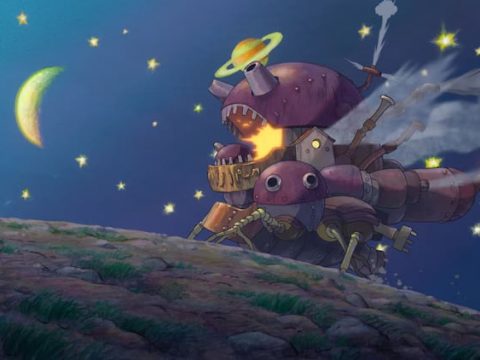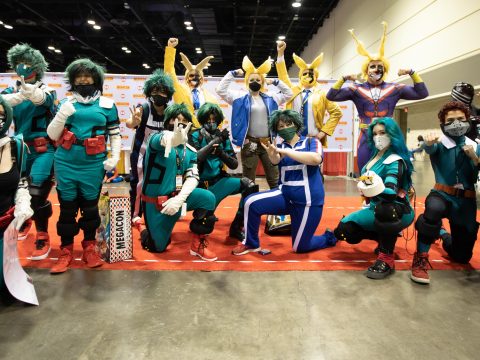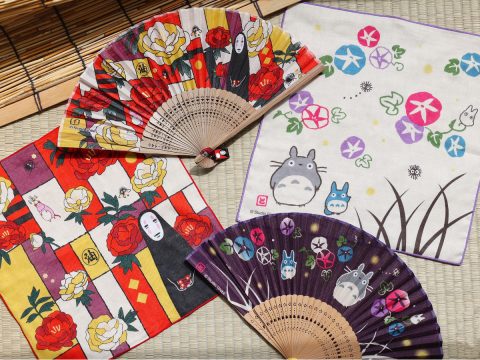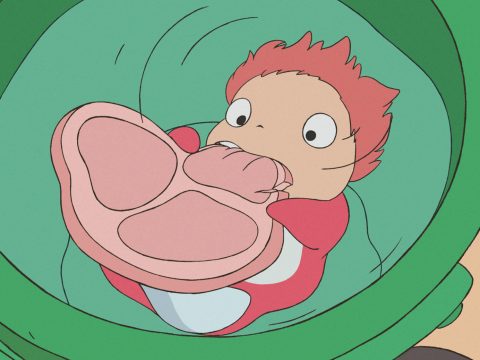Hayao Miyazaki is his own fiercest competition. Even though his films have captured the hearts and minds of audiences both in Japan and abroad, even though Miyazaki’s career as a film-maker spans decades, even though his influence in the world of Japanese animation is second only to Osamu Tezuka, even though he has rightly earned his place as a titan within the industry, I often examine his latest works and find them wanting. What element in Miyazaki’s most recent films has left me in the cold? In a word, it’s the imagery.
Princess Mononoke was a milestone in Miyazaki’s career. It was the first of his films to see an American theatrical release, and it was the first Miyazaki film to incorporate computer graphics into the production. But it was also a turning point thematically and artistically. Mononoke is where Miyazaki’s imagery took a turn for the cynical. Mononoke is not the only Miyazaki film to portray humanity violently at war with the environment; that laurel belongs to Nausicäa of the Valley of the Wind. On the surface, the two films share such similarities as fantastical settings, strong female characters, and morally ambivalent antagonists. But the consequences of the acts of violence in Nausicäa remain largely implied, the strongest example being a few drops of blood dripping off of a sword used to assassinate a king. Compare that to what transpires in Princess Mononoke: a musket bullet passes completely through Ashitaka’s torso, bursting out of his back in a spray of blood. Arrows accidentally empowered by a supernatural curse decapitate and dismember Ashitaka’s foes. Lady Eboshi’s flintlocks strew the battlefield with maimed and mutilated samurai. Weirder still, some of these violent scenes are played for laughs. Can this really be the work of a director renowned for the gentleness and humanism of his films? What has happened here?
Images of blood and gore are not the only imagery that have evolved into something darker in Miyazaki’s films. After all, Mononoke is an anomaly, the only example so far of Miyazaki’s creations that merits a PG-13 content rating. In these films violence and bloodshed is the exception, not the rule. The specter of pollution, both of the physical and spiritual varieties, is a much more common trope. But post-Mononoke, Miyazaki has taken the gloves off regarding pollution imagery. A few bits of litter in an otherwise clear forest stream in My Neighbor Totoro or the smoke-spewing chimneys in Kiki’s Delivery Service remind the viewers of humanity’s impact on the world. In recent efforts, however, goo is king. Slime, muck, oil, and ooze – these are the images Miyazaki uses to express the malignancy of pollution. Whether it’s the tentacle-infested tatari-gami of Mononoke, the burbling Stink Spirit of Spirited Away, or Howl’s slime-slathering tantrum in Howl’s Moving Castle, the images of pollution have become more immediate, more threatening, and much more repulsive.
Even Ponyo – with its return to a gentler aesthetic and less complicated themes – contains imagery that I can only describe as troubling given the director’s previous work. Miyazaki’s feminism is well established. In a medium plagued by shallow and often negative depictions of women, Miyazaki’s female protagonists are usually strong, independent, and replete with positive qualities. And while I see some of this in Ponyo’s rebellious and headstrong personality, I also see a film that is essentially an enormous, phantasmal arranged marriage – a film in which the women are defined entirely by their roles as wives and mothers, in which the parents go off to discuss the nuts and bolts of the nuptials while the children play. When Ponyo presents a young mother with a sandwich and demands that she “make lots of milk” for her baby, I don’t know whether to be amused at Ponyo’s antics or puzzled by what they might imply…
The experience of Miyazaki’s films can often be condensed down into sequences of imagery of such transcendent emotional power that they can move a man to tears. In My Neighbor Totoro, a friendly forest spirit invokes a magical dance to make tiny seeds sprout into an enormous camphor tree with mighty branches that spill across the sky. Then the titular Totoro takes to the air on a spinning top and his joyous bellowing becomes the wind that rustles the rice paddies at night. In Porco Rosso, the spirits of slain biplane pilots form a river of aircraft that meanders into the Heavens. In Castle in the Sky, a young girl floats to Earth as gently as a bit of dandelion fluff, protected by the glow of her magic amulet. Recalling the elegant beauty of these scenes brings tears to my eyes. Where are these images in Princess Mononoke, in Howl’s Moving Castle, in Spirited Away? Miyazaki may have earned his Academy Award, but I’d trade all the bile-spewing, rampaging, faceless ghosts and grotesque parents-into-pigs transformations in the world for one more ride on the Nekobus.
It is dangerous to assume that the director of a film is entirely responsible for everything that appears on screen. But Hayao Miyazaki is a prodigious and prolific creator, not only serving as director but also screenwriter, producer, and chief animation director for many of his films. Perhaps this workload is too much for any one man, even a visionary like Miyazaki, to shoulder. When I see images cribbed from his own earlier works, such as Mae’s tunnel-to-wonders scene from Totoro turned into a sinister parallel in Howl’s Moving Castle, I have to wonder if age and experience have tinted Miyazaki’s visions with a darker shade of pessimism.
Princess Mononoke is © NIBARIKI-TNDG © Buena Vista Home Entertainment, Inc.







